9 Google Ads Bidding Strategies You Need to Know for 2025
- Chase McGowan

- Aug 29
- 16 min read
Navigating the world of Google Ads bidding strategies can feel like a high-stakes gamble, especially when you're stuck with an overpriced, bloated agency. These larger firms often apply generic, one-size-fits-all approaches, wasting your budget on guesswork rather than data-driven decisions that align with your unique business goals. The truth is, selecting the right strategy isn't just about turning on automation; it's about precision, control, and deep strategic insight.
This is where an expert consultant's specialized touch makes a tangible difference. Choosing the perfect bid strategy is a critical decision that directly impacts your profitability and campaign scalability, a nuance often lost in the layers of a large agency. This guide cuts through that noise and agency fluff.
We'll break down the top nine Google Ads bidding strategies with the clarity and actionable insights that impersonal agencies frequently overlook. You will learn not just what each strategy does, but precisely when and how to deploy it for maximum impact. Forget the generic advice. This is your blueprint for making every dollar of your ad spend work smarter, not just harder, to achieve your specific business objectives.
1. Target CPA (Cost Per Acquisition)
Target Cost Per Acquisition (CPA) is one of the most powerful automated Google Ads bidding strategies for advertisers focused on generating leads or sales. This Smart Bidding strategy leverages Google's machine learning to optimize your bids in real-time for every single auction, aiming to get as many conversions as possible at or below the specific acquisition cost you set.
Instead of you manually adjusting bids, Google’s algorithm analyzes a vast array of contextual signals to predict the likelihood of a a click turning into a conversion. This allows for highly precise, auction-time bid adjustments that are nearly impossible to replicate manually. For instance, a SaaS business can set a $200 Target CPA for trial signups, ensuring that their ad spend directly aligns with their customer acquisition cost goals, leading to predictable and profitable growth.
When to Use Target CPA
This strategy is ideal for campaigns with a clear and consistent history of conversions. To effectively use Target CPA, your campaign should have at least 15-30 conversions over the past 30 days. This historical data is crucial as it provides the algorithm with the necessary information to make intelligent bidding decisions from the start.
Actionable Tips for Implementation
Set a Realistic Target: Begin by analyzing your historical data. Set your initial Target CPA slightly higher than your campaign's average CPA from the past 30 days to give the algorithm flexibility during its learning phase.
Allow for a Learning Period: Don't make drastic changes for the first 2-3 weeks. The system needs time to gather data and learn which auctions are most likely to convert for your specific target.
Ensure Flawless Conversion Tracking: Accurate conversion tracking is non-negotiable. Without it, the algorithm is flying blind and cannot optimize effectively. Double-check that your tracking is firing correctly for all desired actions.
The following infographic highlights the key requirements and benefits of using this bidding strategy.
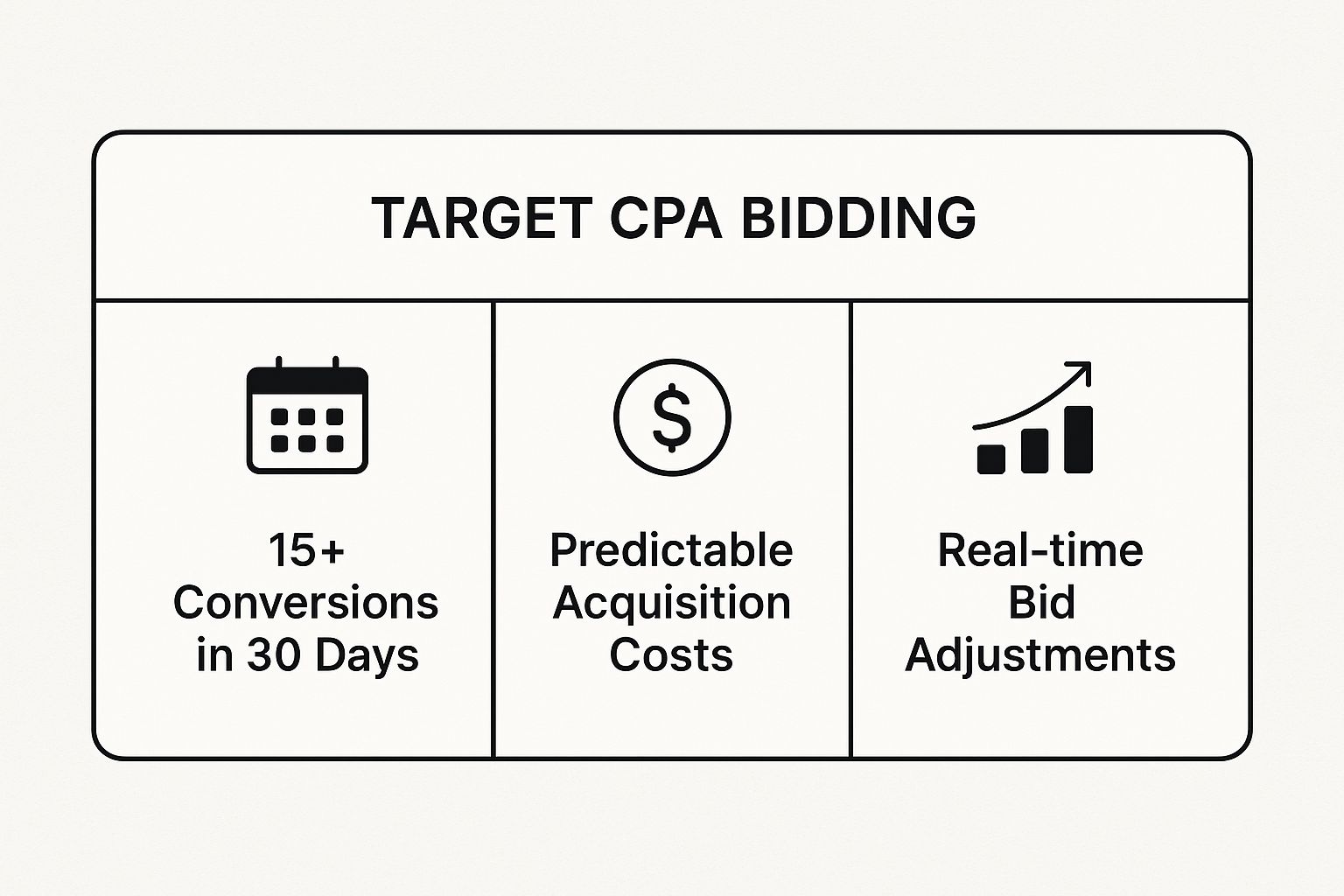
These core components demonstrate how Target CPA shifts your focus from manual bid management to strategic oversight, driving predictable outcomes. As an individual consultant, I ensure my clients have the robust tracking and sufficient conversion history needed for this strategy to succeed, avoiding the common pitfalls that larger, less specialized agencies often overlook. Learn more about optimizing your cost per acquisition to maximize your campaign profitability.
2. Target ROAS (Return On Ad Spend)
Target Return On Ad Spend (ROAS) is a premier automated bidding strategy for advertisers whose primary goal is maximizing revenue from their ad spend. This Smart Bidding strategy uses Google's machine learning to predict conversion value from every ad click, automatically optimizing bids to achieve the highest possible revenue at your specified ROAS target. It shifts the focus from conversion volume to conversion value.
Instead of treating all conversions equally, Google’s algorithm analyzes signals to identify users more likely to make high-value purchases. For example, a fashion brand can set a 500% Target ROAS, instructing Google to prioritize ad placements that lead to a $5 return for every $1 spent. This ensures ad spend is allocated to the most profitable outcomes, directly impacting your bottom line.
When to Use Target ROAS
This strategy is perfect for e-commerce businesses or any advertiser tracking revenue as a conversion value. To use Target ROAS effectively, your campaign should have a solid history of conversion value data, typically at least 15-20 conversions in the last 30 days. This data is essential for the algorithm to understand which user segments drive the most revenue.
Actionable Tips for Implementation
Set Realistic ROAS Targets: Calculate your historical ROAS (Conversion Value / Ad Spend) over the past 30 days and set your initial target at or slightly below that figure. This provides a safe baseline for the learning period.
Ensure Accurate Value Tracking: Your conversion tracking must pass dynamic revenue values back to Google Ads. Inaccurate or static values will render the algorithm ineffective and lead to poor optimization.
Segment for Better Control: For e-commerce, consider creating separate campaigns for product categories with different profit margins. This allows you to set more aggressive ROAS targets on high-margin items.
These foundational elements show how Target ROAS moves your strategy from simply acquiring customers to acquiring profitable customers. As a specialized consultant, I focus on setting up granular value tracking that accurately reflects business profitability, a critical detail often generalized by larger agencies. Learn more about the distinction between ROAS and true ROI to ensure your campaigns are genuinely profitable.
3. Maximize Conversions
Maximize Conversions is a foundational automated bidding strategy designed to achieve the highest possible number of conversions within your specified daily budget. Unlike strategies focused on cost efficiency, its primary goal is volume. Google's algorithm automatically sets the optimal CPC bid for your ad in real-time for every auction, dynamically adjusting to capture as many conversions as possible until your budget is spent.
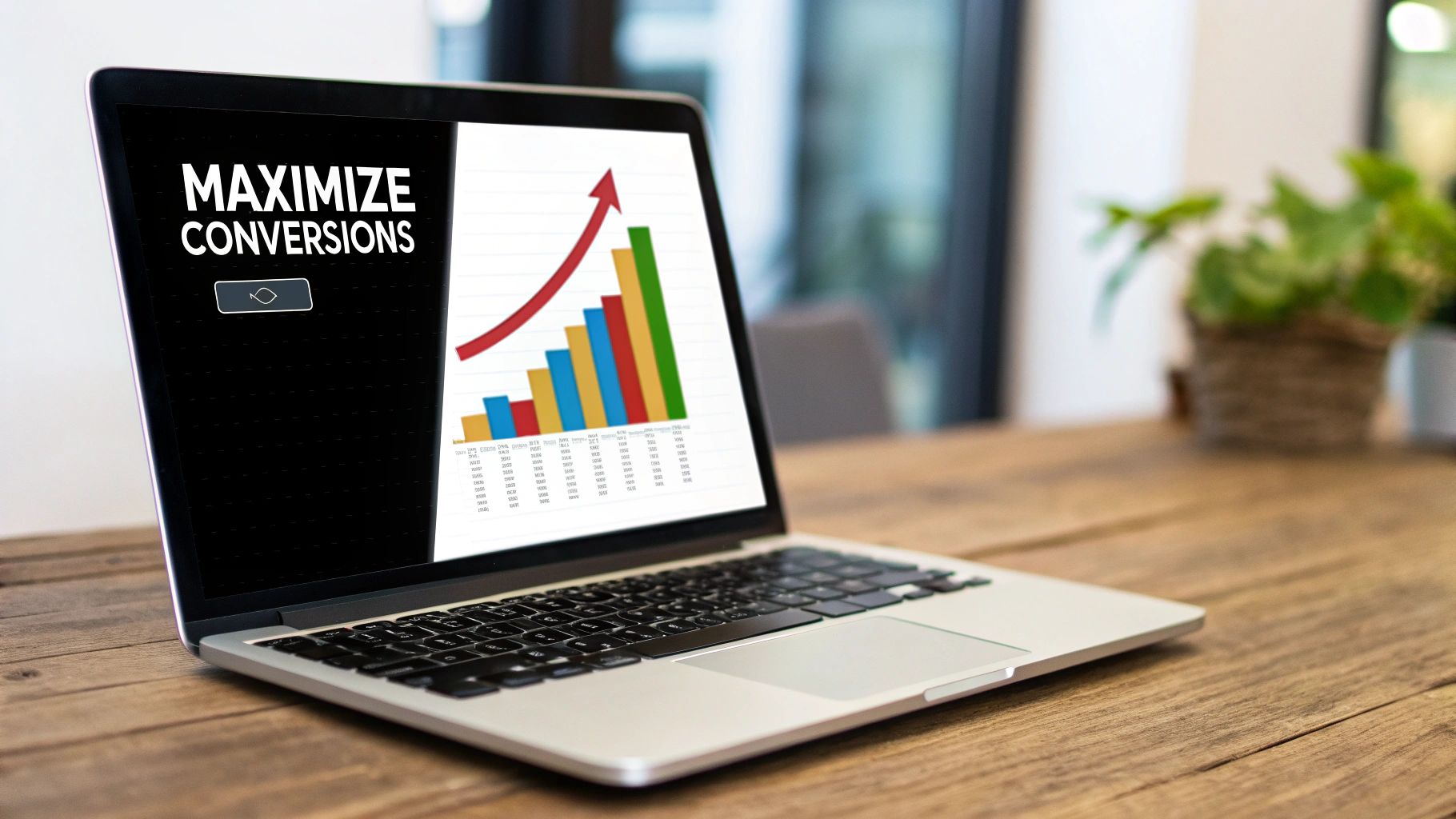
This approach is particularly powerful for advertisers who prioritize generating the maximum number of leads or sales above maintaining a strict cost per action. For example, a startup launching a new app can use Maximize Conversions to generate the highest number of initial downloads, or an event company can leverage it to sell as many tickets as possible before a registration deadline. It's about spending your budget as effectively as possible to drive pure volume.
When to Use Maximize Conversions
This strategy is best suited for campaigns where the main objective is to generate the highest quantity of conversions, especially when you are not yet certain of your ideal cost per acquisition. It's an excellent choice for new campaigns with limited historical data, time-sensitive promotions, or any scenario where lead or sales volume is the top priority over cost efficiency.
Actionable Tips for Implementation
Set an Appropriate Daily Budget: The algorithm will aim to spend your full daily budget. Ensure it's set to a level you are comfortable with, as the cost-per-conversion can fluctuate.
Allow for a Learning Period: Like other Smart Bidding strategies, Maximize Conversions needs time to learn. Avoid making significant changes for the first 1-2 weeks as the system gathers performance data.
Monitor CPA Trends: While this strategy doesn't let you set a CPA target, you must still monitor the effective CPA. If costs become unsustainable, it may be time to transition to Target CPA.
These components make Maximize Conversions a crucial tool for growth-focused campaigns. As a specialized consultant, I help clients use this strategy to quickly ramp up volume and gather valuable conversion data, a critical first step that larger agencies often mismanage by focusing prematurely on efficiency metrics. This targeted approach ensures your initial ad spend is used to build momentum and inform a more refined, long-term strategy.
4. Maximize Conversion Value
Maximize Conversion Value is a powerful automated bidding strategy designed for advertisers whose primary goal is to generate the highest possible revenue or value from their ad spend. This Smart Bidding strategy leverages Google's machine learning to automatically optimize bids in real-time for each auction, aiming to maximize the total value of conversions within your specified budget.
Instead of focusing on the number of conversions like Target CPA, this strategy prioritizes conversions that are more valuable to your business. Google’s algorithm analyzes historical data and contextual signals to predict the potential conversion value of a click. For example, an e-commerce store can use this to automatically bid higher for users likely to purchase high-margin products, ensuring their budget is spent driving maximum revenue, not just transaction volume.
When to Use Maximize Conversion Value
This strategy is perfect for businesses where different conversions hold different values, such as e-commerce stores with varied product pricing or B2B companies that assign values based on lead quality. It requires robust conversion tracking with associated values to function correctly. The campaign should have a history of conversions with values so the algorithm can effectively learn and optimize.
Actionable Tips for Implementation
Ensure Accurate Conversion Value Setup: Your conversion tracking must pass dynamic values back to Google Ads. For e-commerce, this is typically the order total. For lead generation, you might assign static values based on the lead's potential lifetime value.
Use for Campaigns with Value Variation: This strategy shines when there's a significant difference in the value of potential conversions. If all your conversions are worth the same, Target CPA or Maximize Conversions might be a better fit.
Set a Sufficient Budget: Unlike Target ROAS, this strategy will aim to spend your full daily budget. Ensure the budget is set at a level you're comfortable with, as the system will prioritize spending it to capture all valuable opportunities.
These core components show how Maximize Conversion Value shifts the focus from conversion volume to overall profitability. As a specialized consultant, I help clients implement the complex value-based tracking required for this strategy to succeed, a critical step that larger, less hands-on agencies often overlook, leading to misaligned optimization and wasted ad spend.
5. Enhanced CPC (ECPC)
Enhanced Cost Per Click (ECPC) is a semi-automated bidding strategy that combines the control of manual bidding with the intelligence of Google's machine learning. This hybrid approach automatically adjusts your manually set bids for clicks that seem more or less likely to lead to a conversion. Essentially, ECPC acts as a safety net, giving Google the permission to increase or decrease your bids in real-time to help you secure more conversions.
Unlike fully automated strategies, ECPC still revolves around your base CPC bids, giving you a foundational level of control over your ad spend. For example, a business testing the waters of automation can use ECPC to see how Google's algorithm performs without completely relinquishing control, providing a safe transition into more advanced Google Ads bidding strategies. This measured approach ensures you leverage machine learning while retaining direct influence over your bids.
When to Use ECPC
This strategy is perfect for advertisers who want to dip their toes into automated bidding without going all-in. It's an excellent stepping stone for campaigns transitioning from Manual CPC to a fully-fledged Smart Bidding strategy like Target CPA. It's also effective for campaigns that have limited conversion data or experience irregular conversion patterns, where a fully automated system might struggle.
Actionable Tips for Implementation
Start with Existing Campaigns: Enable ECPC on a stable campaign currently using Manual CPC to establish a clear performance baseline. This allows you to accurately measure the uplift in conversions.
Monitor Bid Adjustments: Pay close attention to how ECPC modifies your bids. This insight can help you understand which segments of your audience are most valuable and inform your manual bid adjustments.
Combine with Manual Optimizations: ECPC enhances your manual bids; it doesn't replace the need for them. Continue to adjust your base bids for keywords, devices, and locations based on performance data.
ECPC provides a balanced approach, blending manual oversight with algorithmic power. As a specialized consultant, I often use ECPC as a strategic bridge for clients, guiding them from manual processes to sophisticated automation. This careful, phased transition avoids the "set it and forget it" mentality of larger agencies, ensuring that every step is data-driven and tailored to the client's specific business goals.
6. Manual CPC Bidding
Manual Cost-Per-Click (CPC) Bidding is the original Google Ads bidding strategy, offering advertisers complete and granular control over their ad spend. With this approach, you manually set the maximum amount you are willing to pay for each individual click on your ads. This hands-on method allows for precise bid management at the keyword or ad group level, ensuring your budget is allocated exactly as you see fit.
Unlike automated strategies, Manual CPC gives you the final say on every bid. For example, a small business with a tight budget can set a low maximum bid of $1.50 for a broad keyword but a higher bid of $4.00 for a high-intent, long-tail keyword. This level of control is essential when testing new markets or managing highly specialized campaigns where every click's value is meticulously scrutinized.
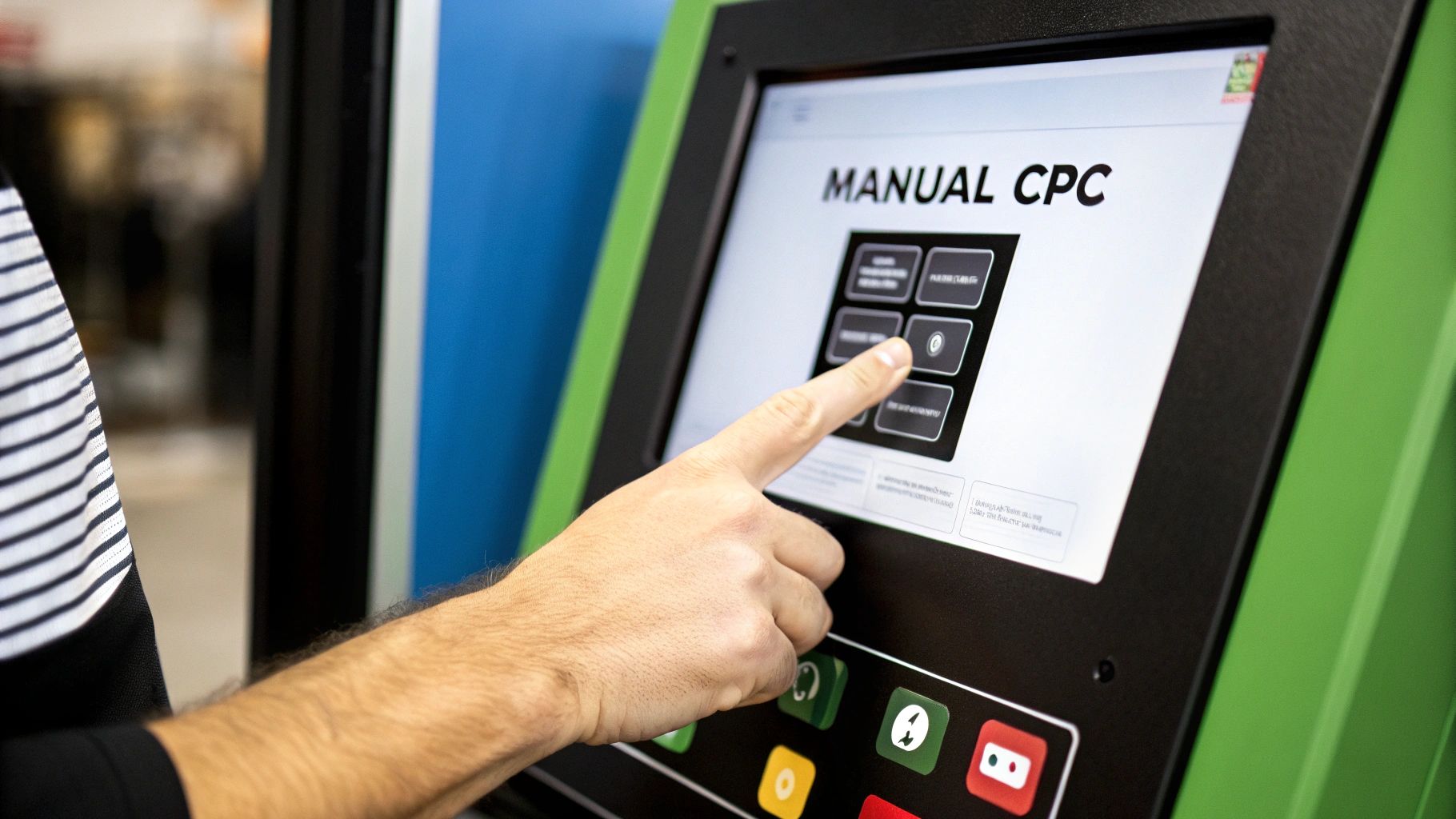
When to Use Manual CPC Bidding
This strategy is ideal for advertisers who need maximum control, have very limited budgets, or are in the early stages of a campaign without sufficient conversion data for automated bidding. It is also highly effective for experienced advertisers who want to make micro-adjustments based on their own performance analysis rather than relying on an algorithm.
Actionable Tips for Implementation
Analyze Performance Regularly: Continuously monitor keyword performance. Increase bids on keywords that are converting profitably and decrease or pause those that are not delivering a positive return on investment.
Implement Bid Adjustments: Use bid adjustments to modify your bids based on device type, geographic location, or time of day. For instance, if you know your customers convert more often on desktops during business hours, you can increase bids accordingly.
Start with Conservative Bids: When launching a new campaign, set your initial bids at a conservative level. You can gradually increase them as you gather data and identify which keywords are driving the best results.
Manual CPC Bidding puts you in the driver's seat, allowing for strategic decisions that automated systems might miss. As a specialized consultant, I leverage this control to protect my clients' budgets and meticulously test new campaign variables, a granular focus that larger agencies often cannot provide due to their scale and standardized processes.
7. Target Impression Share
Target Impression Share is an automated bidding strategy designed purely for visibility. This strategy automatically sets your bids with the goal of showing your ad in a specific location on the search results page: the absolute top, anywhere on the top, or anywhere on the page. You simply tell Google the percentage of impressions you want to capture for that placement.
Instead of optimizing for clicks or conversions, Google's algorithm focuses on winning auctions to meet your visibility goal. This makes it a powerful tool for brand awareness campaigns. For instance, a luxury car brand can use this strategy to ensure their ads appear in the top position 90% of the time for high-value branded searches, reinforcing their premium market position and dominating the digital shelf space.
When to Use Target Impression Share
This strategy is ideal for campaigns where brand presence and visibility are the primary objectives, rather than direct conversions. It's most effective for branded search campaigns or top-of-funnel awareness initiatives where owning a particular search term is critical to your marketing strategy. This approach is less concerned with direct ROI and more focused on market dominance.
Actionable Tips for Implementation
Set a Max CPC Bid Limit: This is a crucial control. Without a maximum CPC limit, Google can bid as high as necessary to achieve your impression share goal, which can quickly exhaust your budget.
Use for Brand and Awareness: This strategy shines in branded campaigns or when launching a new product. Avoid using it for bottom-of-funnel, conversion-focused campaigns where efficiency is key.
Monitor Performance Closely: Keep an eye on your CPC and click-through rates. High impression share is valuable, but not if it comes at an unsustainable cost with low engagement.
These core components allow you to prioritize visibility over direct response metrics, a vital part of a comprehensive marketing funnel. As an individual consultant, I help clients strategically deploy Target Impression Share for brand defense and awareness, ensuring it complements their performance-driven campaigns without cannibalizing their budget, a nuance often missed by larger agencies focused solely on conversions. Learn more about what impression share is and how to boost it to enhance your ad performance.
8. Maximize Clicks
Maximize Clicks is an automated bidding strategy designed to generate the highest possible number of clicks within a specified daily budget. Google’s system automatically sets your bids to help get as much traffic to your website as possible, making it a straightforward choice for campaigns where the primary goal is driving visitor volume.
Instead of focusing on conversions or value, this strategy prioritizes raw traffic. For instance, a content publisher running a blog that earns revenue from display ads can use Maximize Clicks to drive a large volume of page views. Similarly, a new business launching its first website can use this strategy to build initial brand awareness and gather valuable visitor data by simply getting more people to their site.
When to Use Maximize Clicks
This strategy is best suited for top-of-funnel campaigns where the main objective is brand awareness or traffic generation, not direct conversions. It's an excellent starting point for new accounts that lack the historical conversion data required for more advanced Smart Bidding strategies like Target CPA or Target ROAS. It helps to quickly gather performance data that can inform future optimization.
Actionable Tips for Implementation
Set a Maximum CPC Bid Limit: While Google manages the bids, setting a max CPC limit is crucial. This prevents the algorithm from spending excessively on a single click and gives you control over your cost-per-click.
Monitor Engagement Metrics: Clicks are only valuable if they lead to engaged users. Keep a close eye on metrics like bounce rate, pages per session, and average session duration in Google Analytics to ensure you're attracting a quality audience.
Layer with Strong Targeting: Since this strategy focuses on volume, precise audience targeting is essential to avoid irrelevant traffic. Use specific keywords, affinity audiences, or in-market segments to ensure your ads reach the right people.
These foundational elements show how Maximize Clicks can serve as a powerful tool for building initial campaign momentum. Unlike large agencies that might push complex strategies prematurely, I often recommend Maximize Clicks to new clients. This allows us to gather crucial performance data quickly and cost-effectively, building a solid foundation before transitioning to conversion-focused bidding.
9. Portfolio Bid Strategies
Portfolio Bid Strategies are an advanced approach within Google Ads that groups multiple campaigns, ad groups, and keywords together to be optimized under a single automated bidding strategy. This allows Google's machine learning to allocate your budget and set bids across your entire portfolio, aiming to achieve a collective performance goal like a shared Target CPA or Target ROAS.
Instead of managing bids campaign by campaign, this strategy makes holistic, real-time adjustments across the entire group. For example, an e-commerce brand with separate campaigns for different product categories can use a portfolio strategy to hit an overall ROAS target. The algorithm might bid more aggressively in a high-performing campaign while pulling back in another, all to maximize total conversion value for the set budget.
When to Use Portfolio Bid Strategies
This strategy is ideal for advertisers managing multiple campaigns that share similar business objectives and target metrics. It's particularly effective for accounts with enough conversion volume spread across several campaigns, as the shared data pool gives the algorithm more information to work with, leading to smarter, more efficient bidding decisions across the board.
Actionable Tips for Implementation
Group Logically: Combine campaigns with similar goals, audiences, and performance targets. Grouping a lead generation campaign with a brand awareness campaign in the same portfolio will confuse the algorithm.
Ensure Sufficient Data: The combined conversion volume of all campaigns in the portfolio must be strong. A lack of sufficient data will hinder the algorithm's ability to optimize effectively.
Monitor Individual Performance: While the strategy optimizes for a collective goal, it's crucial to still monitor the performance of individual campaigns within the portfolio to ensure none are being starved of budget or are severely underperforming.
Portfolio strategies demonstrate the power of aggregated data in Google Ads bidding strategies, allowing for a level of cross-campaign optimization that is impossible to achieve manually. As an individual consultant, I specialize in structuring these complex portfolios for my clients, ensuring that the right campaigns are grouped to maximize efficiency, a strategic nuance often missed by larger agencies that apply one-size-fits-all solutions.
Google Ads Bidding Strategies: 9-Point Comparison
Bidding Strategy | Implementation Complexity 🔄 | Resource Requirements 📊 | Expected Outcomes ⭐ | Ideal Use Cases 💡 | Key Advantages ⚡ |
|---|---|---|---|---|---|
Target CPA | Medium - requires conversion data and tracking setup | Requires 15+ conversions in 30 days | Predictable acquisition costs, conversion optimization | E-commerce, SaaS, lead gen with steady conversions | Saves time, reduces manual bids, cross-device optimization |
Target ROAS | High - needs accurate value tracking and complex setup | Requires substantial conversion value data | Maximizes revenue and profitability | Retail, travel, fashion with variable product margins | Optimizes profitability, adapts to seasonal trends |
Maximize Conversions | Low - simple setup, no target CPA needed | Uses full budget, less data needed | Maximum conversion volume | Startups, events, app launches aiming for volume | Efficient budget use, minimal management |
Maximize Conversion Value | Medium - requires conversion values setup | Conversion value tracking necessary | Maximizes total conversion value | E-commerce during promotions, B2B high-value leads | Revenue-focused, budget-efficient |
Enhanced CPC (ECPC) | Low to medium - hybrid manual and automated control | Works with limited conversion data | Moderate conversion optimization | Agencies transitioning to automation, fluctuating campaigns | More control, no learning period needed |
Manual CPC Bidding | High - fully manual, time-intensive | No data requirements | Full control, predictable costs | Small businesses, niche campaigns, test markets | Precise keyword control, immediate changes |
Target Impression Share | Medium - needs CPC caps, focus on visibility | Requires budget for high visibility | Guaranteed ad visibility | Brand awareness, branded campaigns, competitive defense | Predictable impression delivery, brand presence |
Maximize Clicks | Low - simple setup, budget-focused | Minimal data requirements | High traffic volume | Publishers, new businesses, awareness campaigns | Maximizes traffic, easy to implement |
Portfolio Bid Strategies | High - complex setup for multiple campaigns | Requires significant data volume | Holistic optimization across portfolio | Large accounts with multiple campaigns, agencies | Simplifies management, improves performance |
Choosing Strategy Over Automation: Your Path to Profitability
Navigating the landscape of Google Ads bidding strategies can feel like deciphering a complex code. We've explored a wide array of options, from the awareness-focused Target Impression Share to the profit-driven Target ROAS and the granular control of Manual CPC. Each strategy serves a distinct purpose, offering a unique lever to pull depending on whether your primary goal is visibility, lead generation, or maximizing revenue from every dollar spent.
The journey from understanding these strategies to mastering them is where true competitive advantage is forged. The critical takeaway is this: Google's automation is a powerful engine, but it requires a skilled pilot. Relying solely on the algorithm without a bespoke strategic framework is like having a race car with no one in the driver's seat. This is the precise gap where many businesses falter, often when partnered with large, impersonal agencies that apply a one-size-fits-all, "set it and forget it" approach to account management.
From Theory to Tangible Results
The real art and science of Google Ads lies in the continuous process of selection, observation, and optimization. It's about knowing when to pivot from Maximize Conversions to Target CPA once you have sufficient data, or when to segment campaigns to use different bidding strategies for high-intent versus top-of-funnel keywords. This strategic layer of management is what prevents wasted ad spend and transforms a campaign from a cost center into a reliable growth engine.
Your choice of Google Ads bidding strategies directly dictates your account's performance ceiling. An ill-fitting strategy can lead to:
Wasted Budget: Spending on clicks that don't align with your business objectives.
Missed Opportunities: Failing to capture valuable conversions because your bids are not competitive enough.
Poor ROI: Achieving conversions at a cost that erodes your profit margins.
Conversely, a well-chosen and expertly managed bidding strategy aligns your ad spend directly with your most important business outcomes. This is the difference between simply being present on the search network and dominating it. It requires active, specialized oversight, not a passive reliance on automation. This hands-on, strategic approach is the core philosophy of a dedicated consultant, a stark contrast to the often bloated and disconnected service from a large-scale agency.
The strategies we've detailed are your tools. Now, the challenge is to build a customized blueprint that leverages them for maximum impact, ensuring your investment doesn't just generate activity, but delivers predictable, profitable growth.
Ready to move beyond generic advice and implement Google Ads bidding strategies that are meticulously tailored to your business goals? As an expert consultant at Come Together Media LLC, I specialize in providing the strategic oversight that turns ad spend into predictable revenue. Let's build a profitable path forward together. Click here for a free, no-commitment consultation to audit your current campaigns.




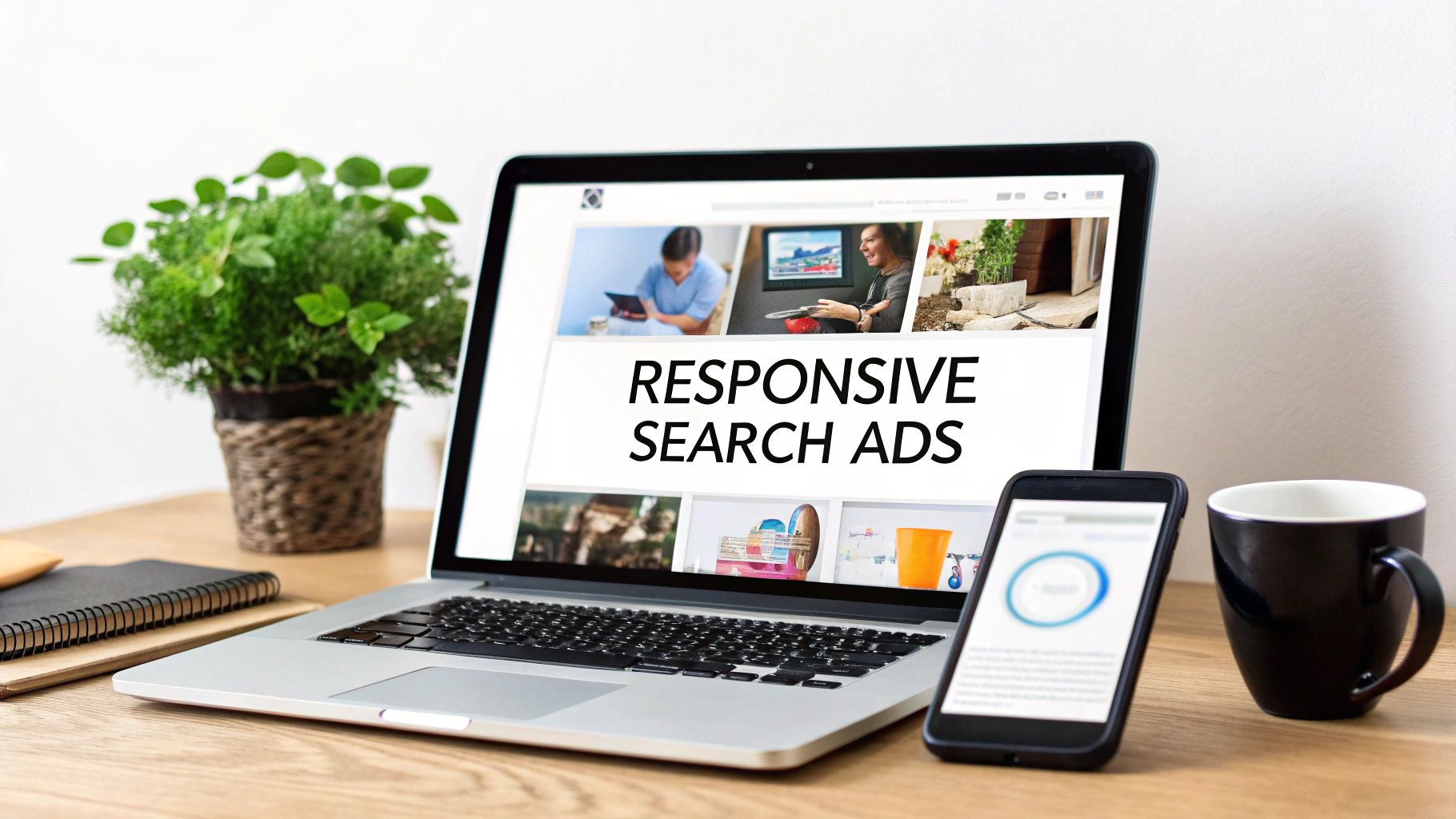
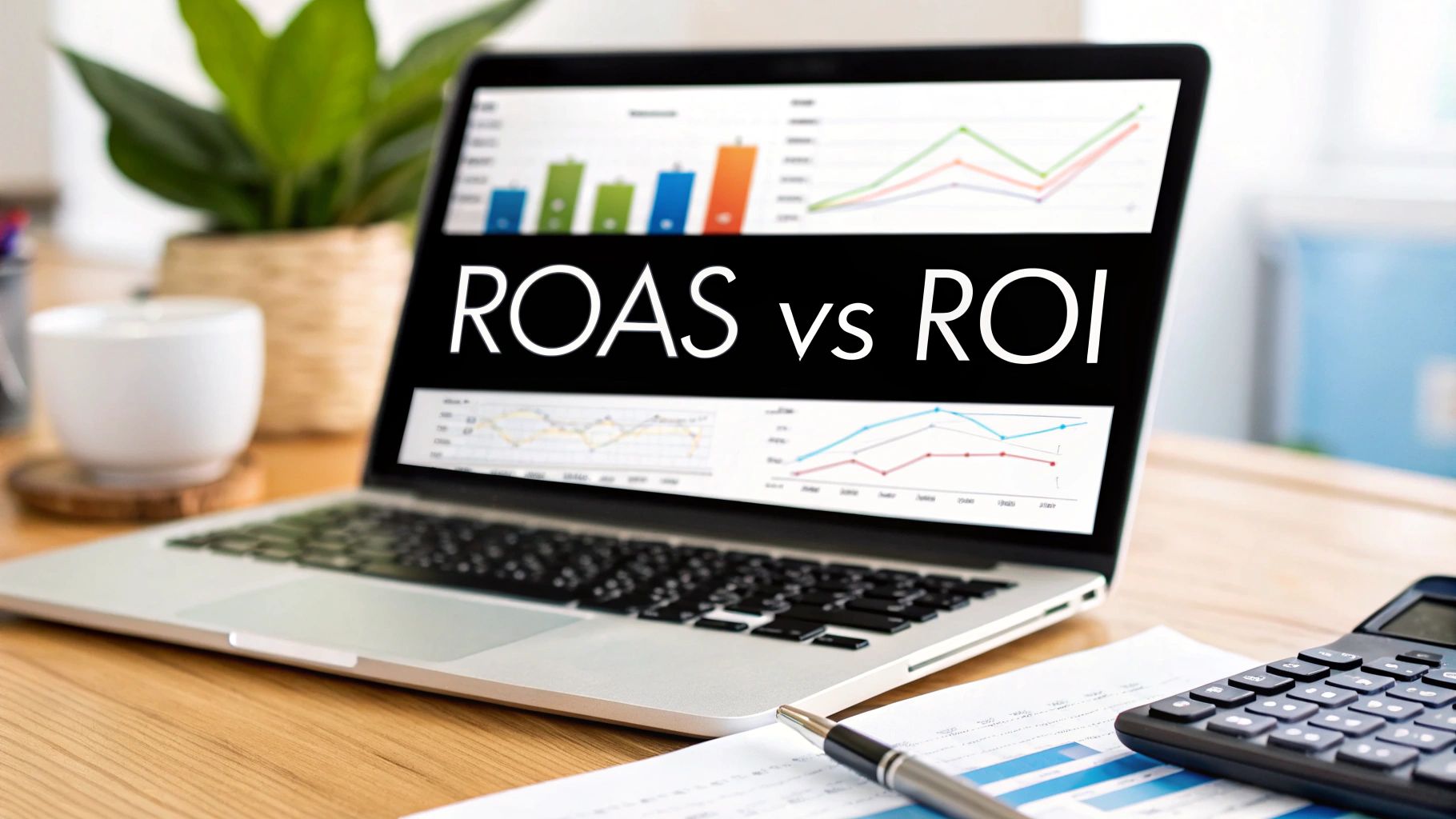
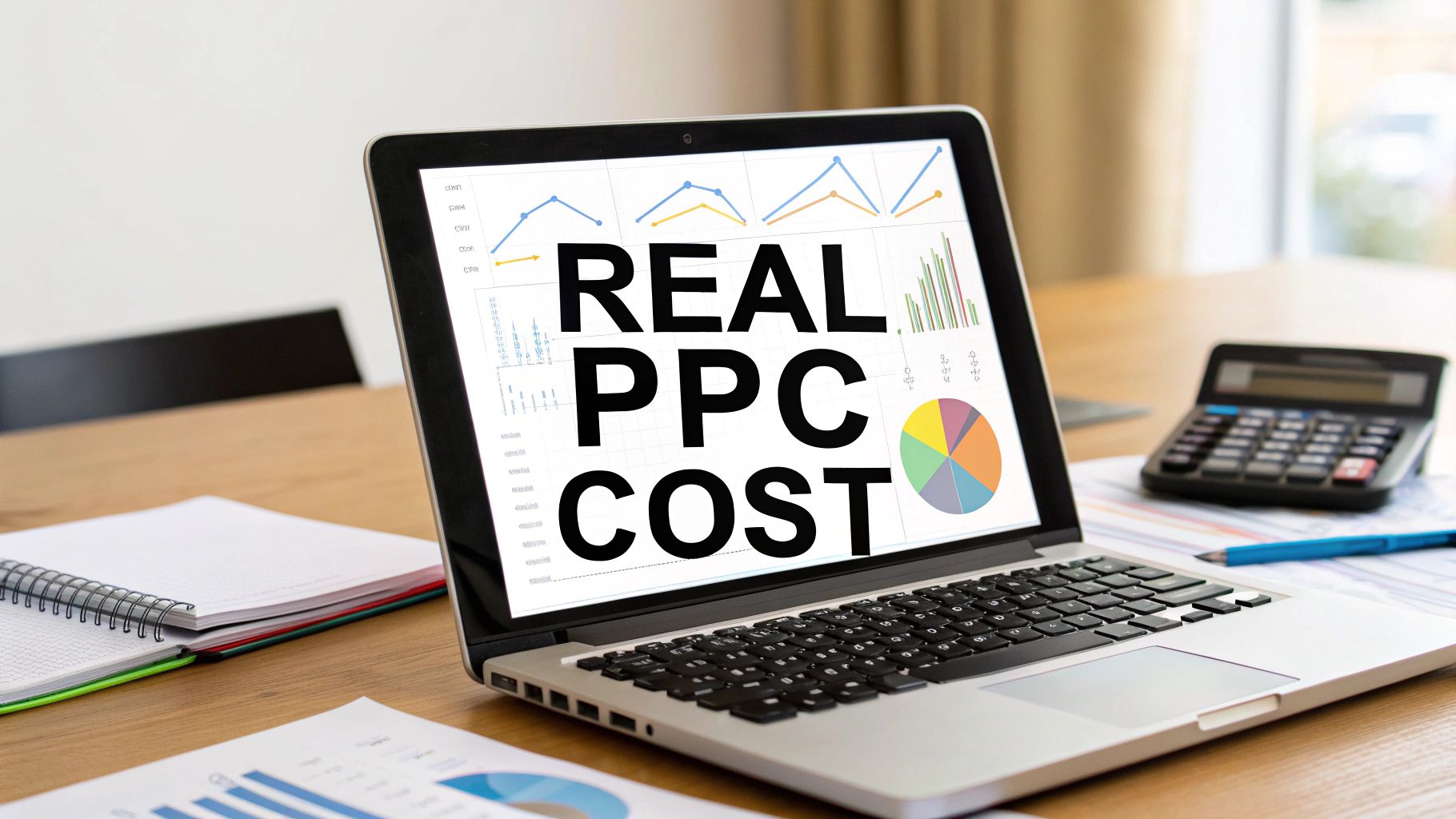
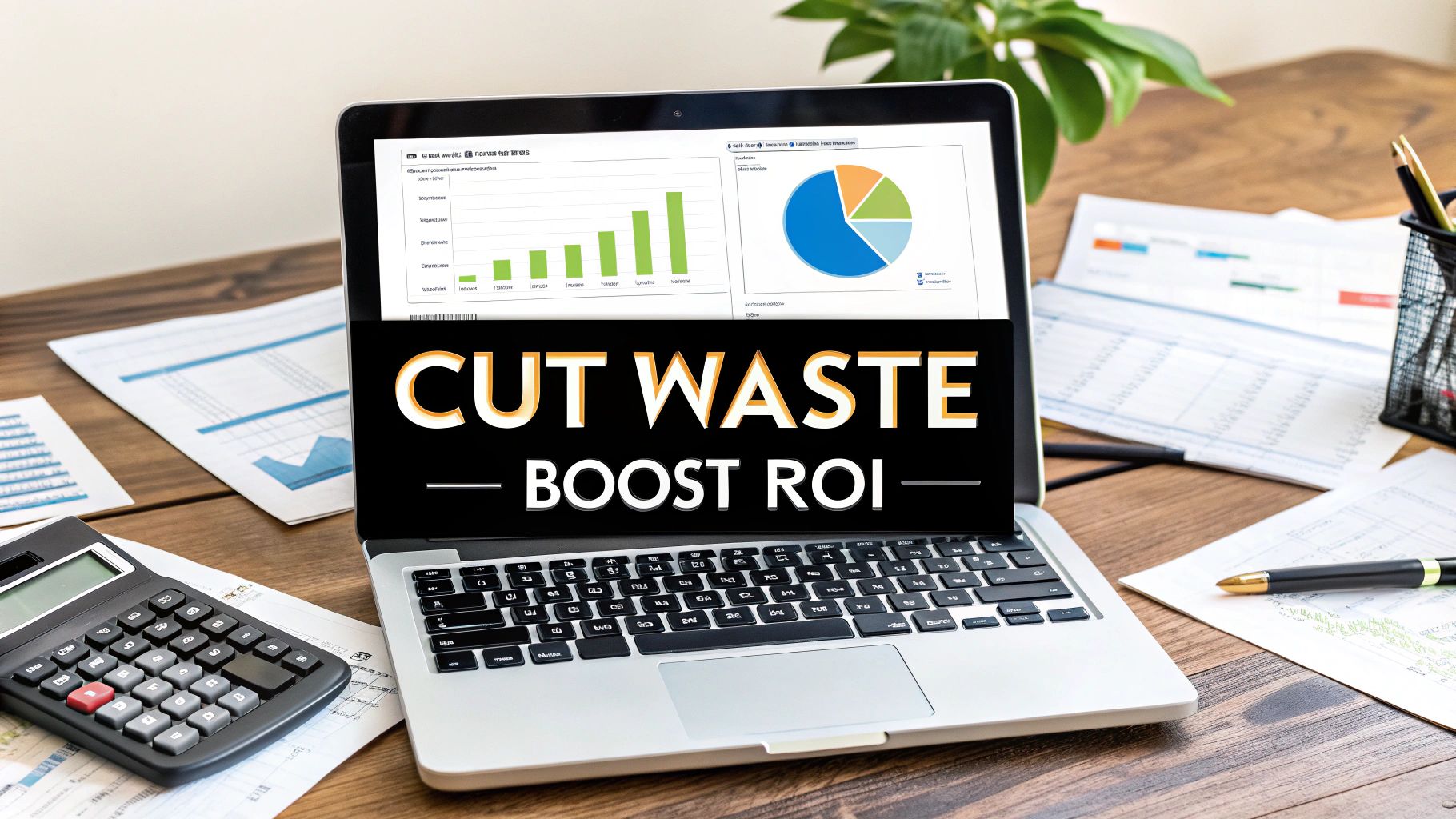
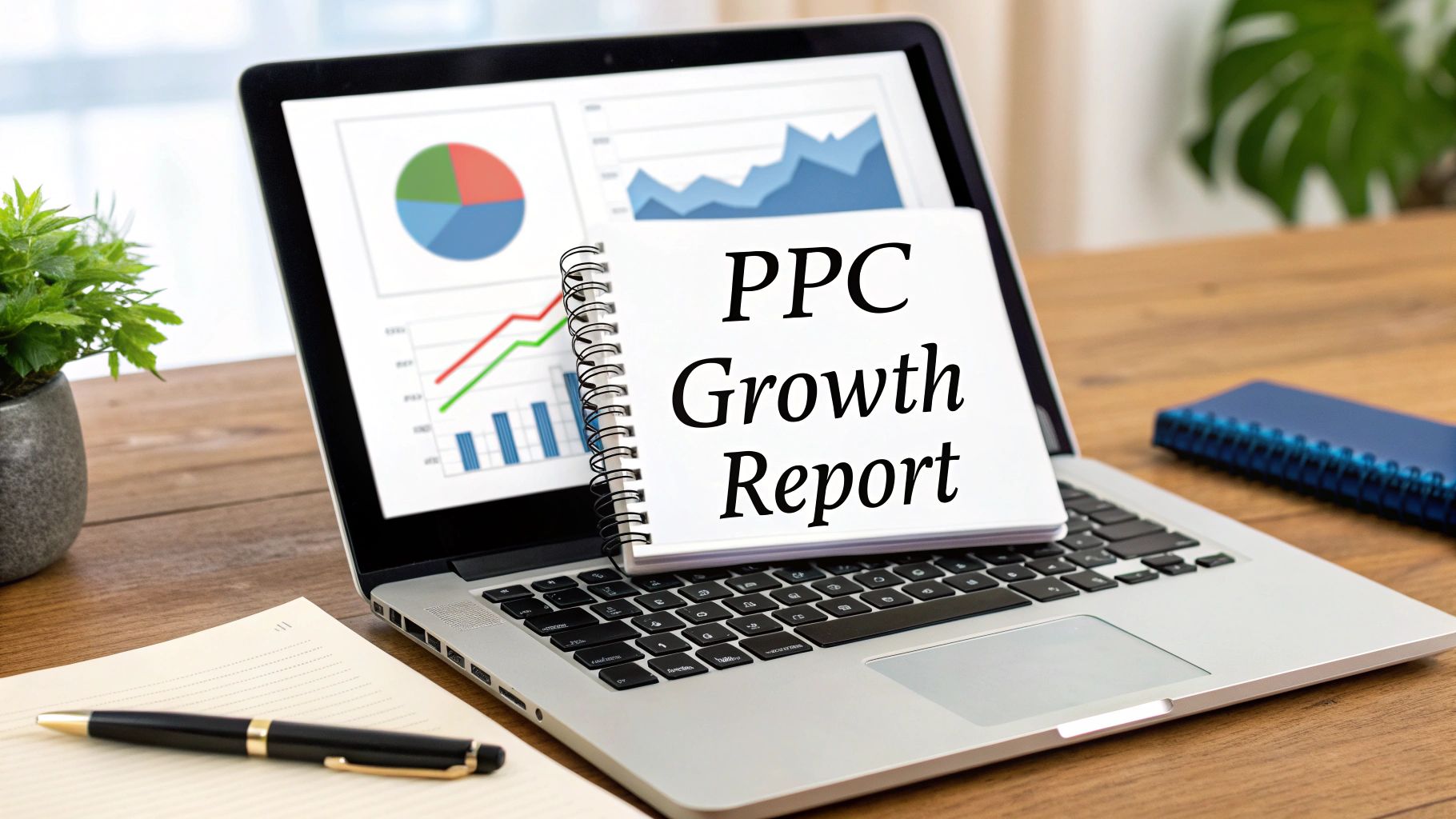
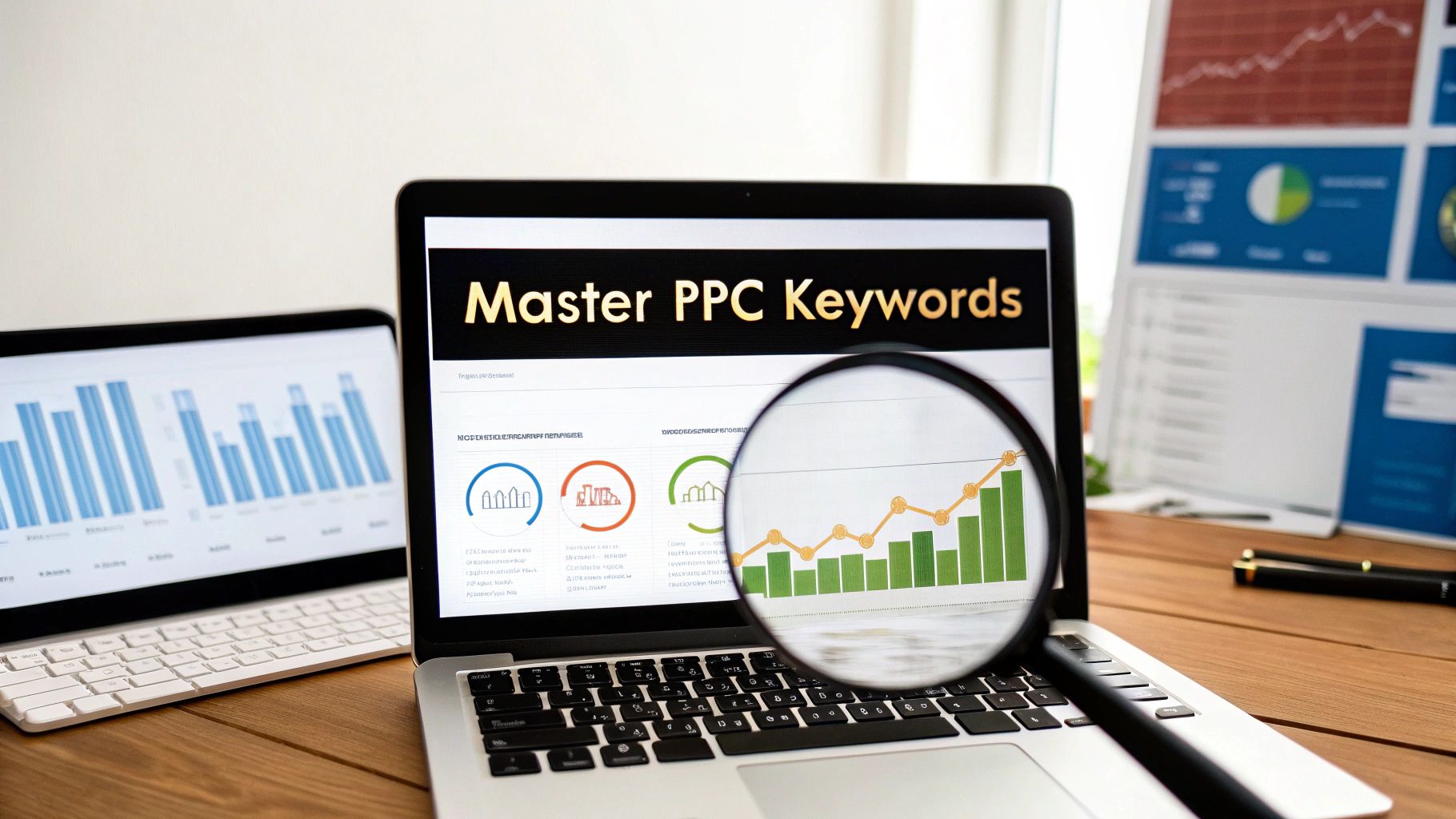
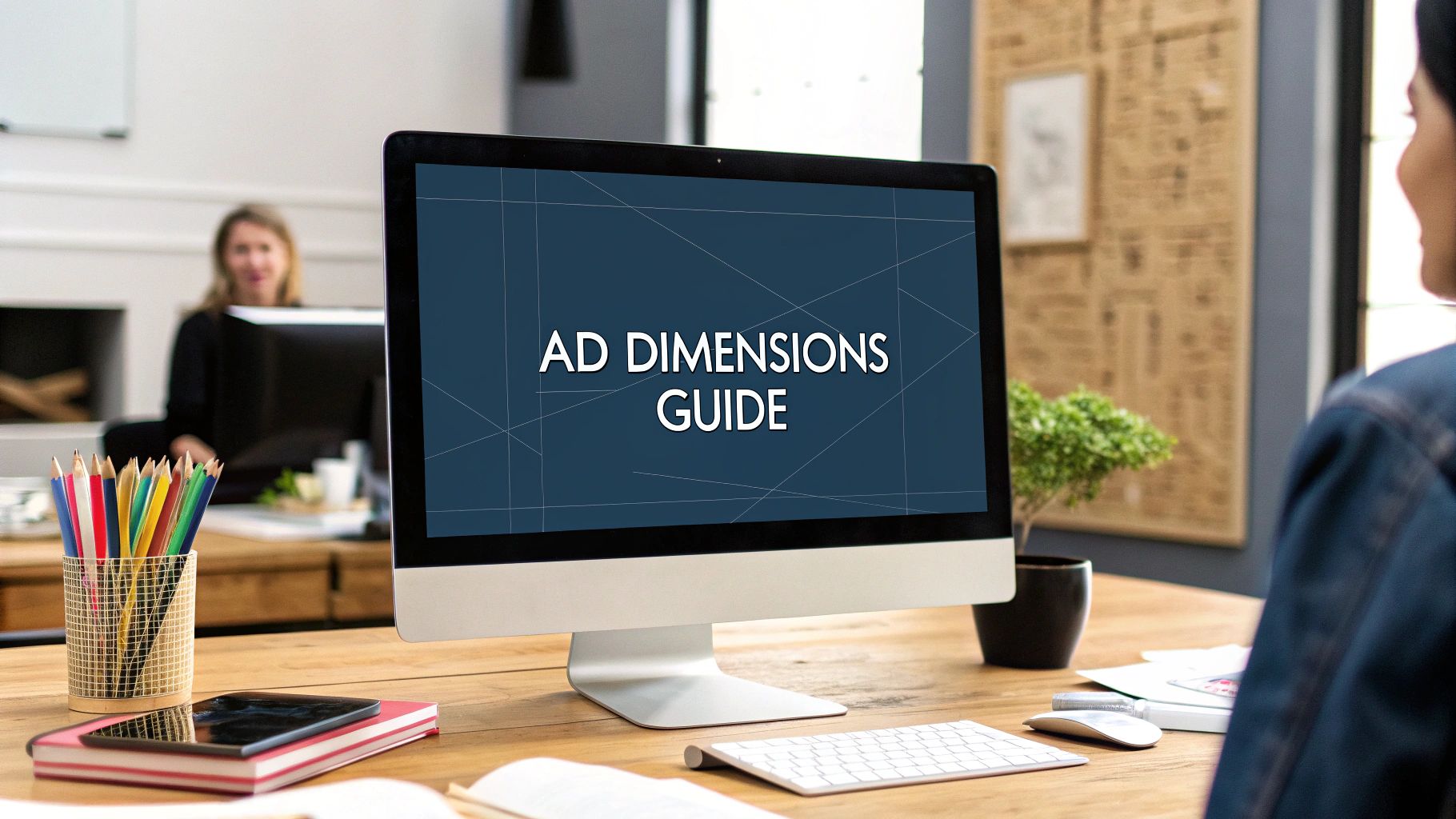
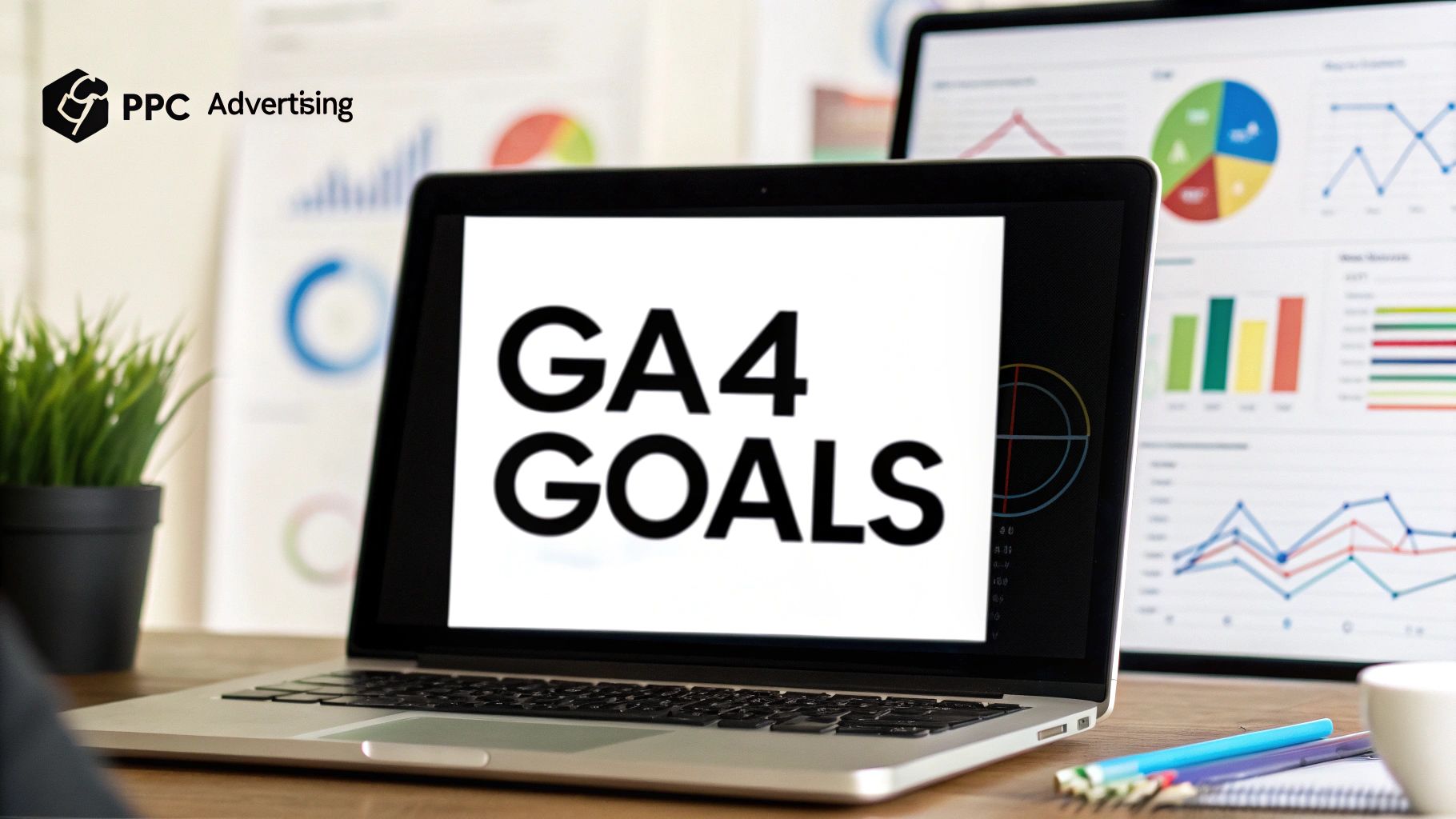
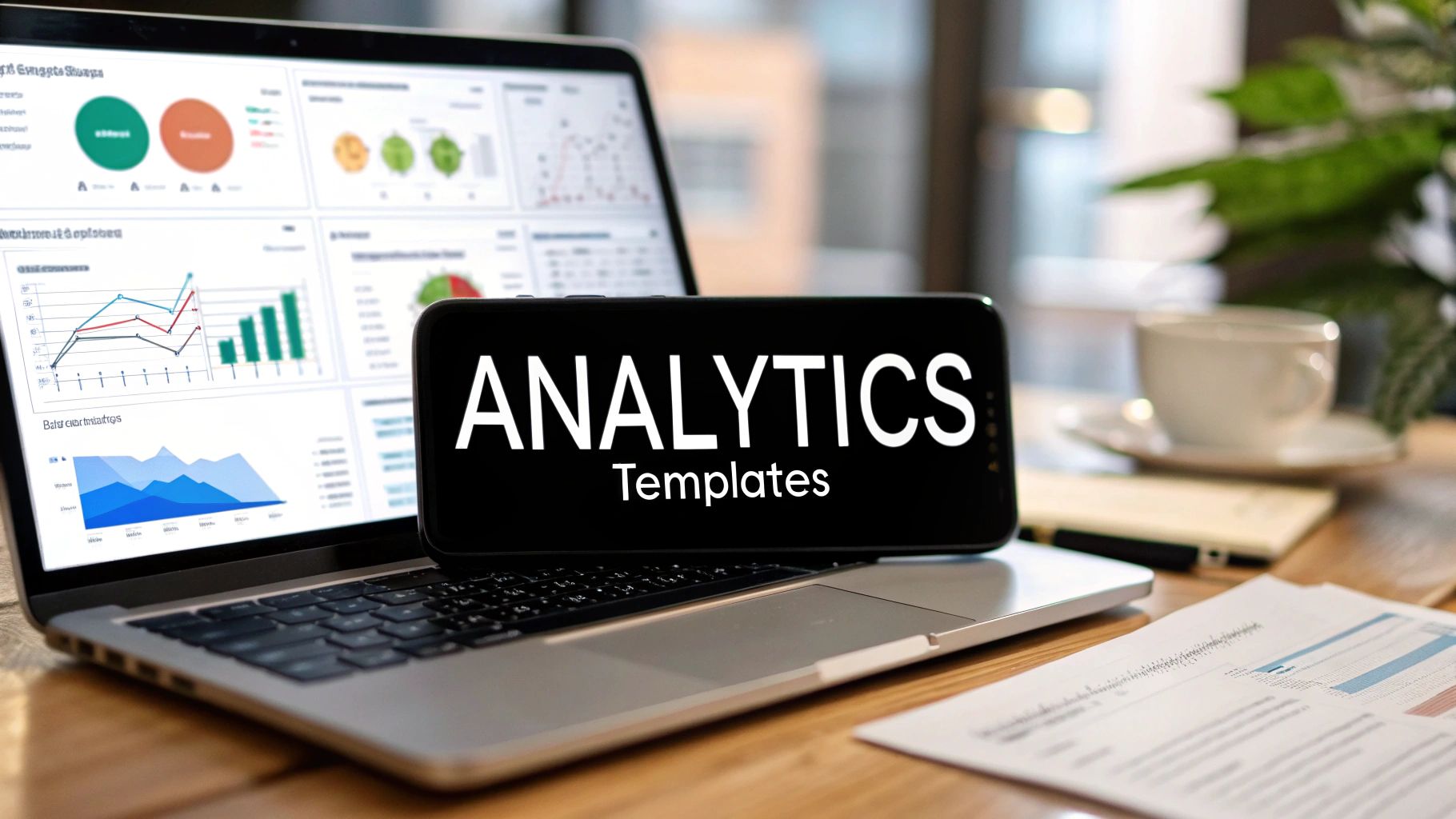
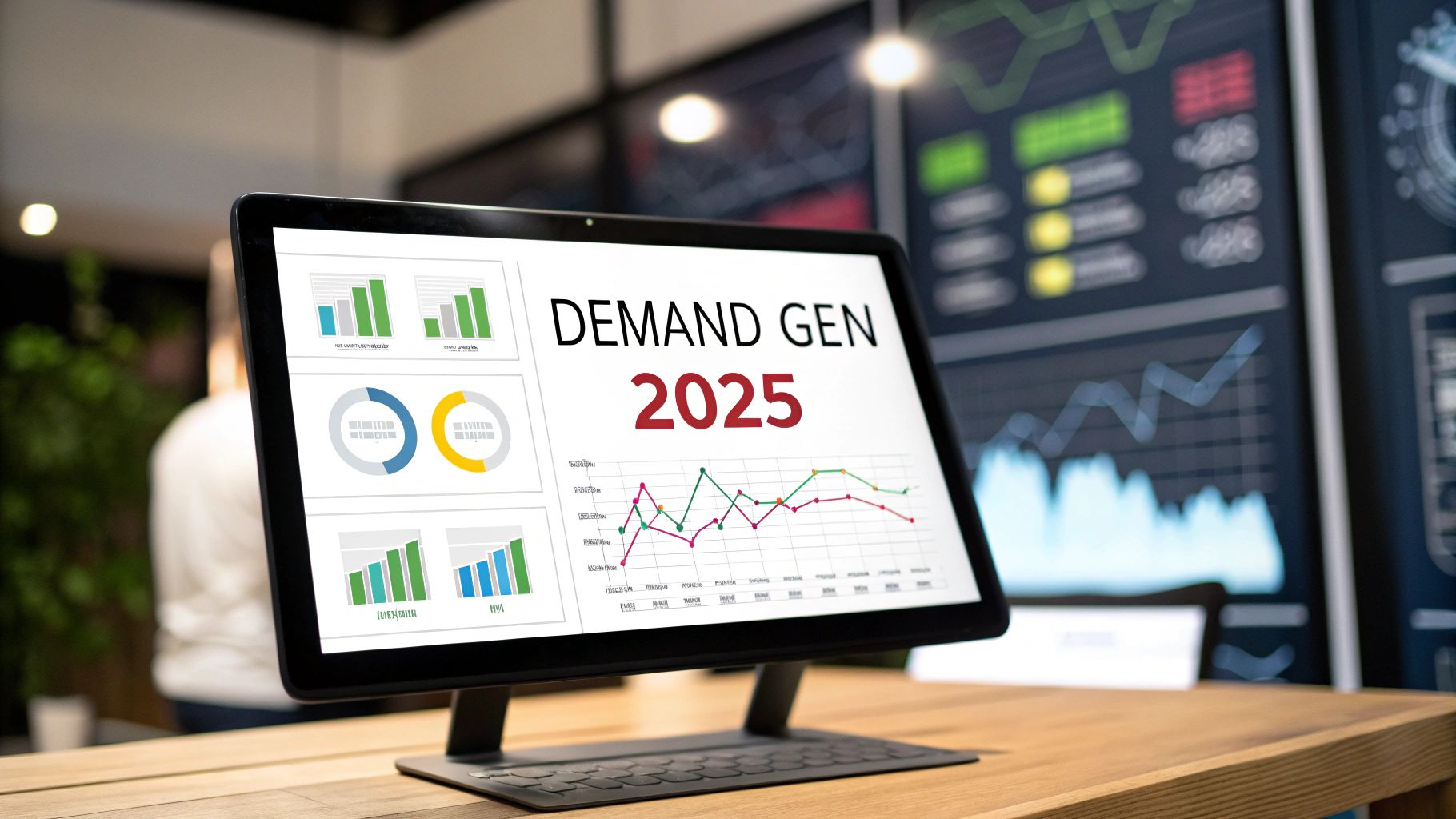
Comments